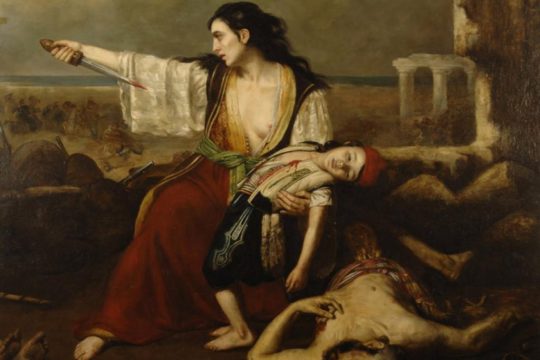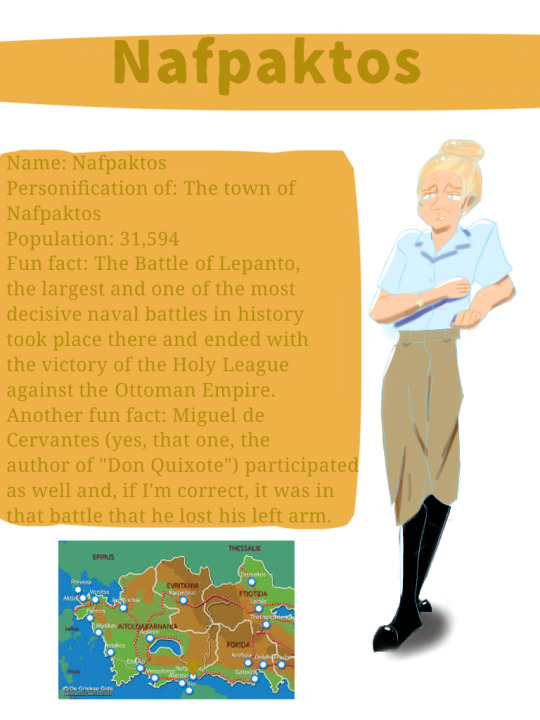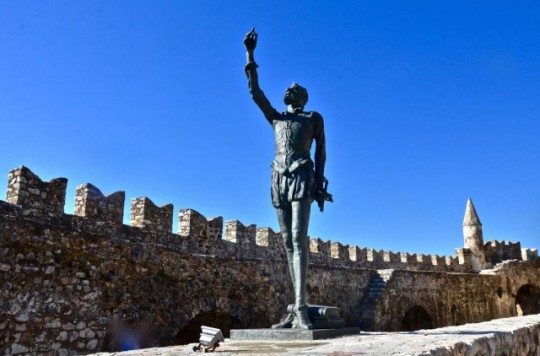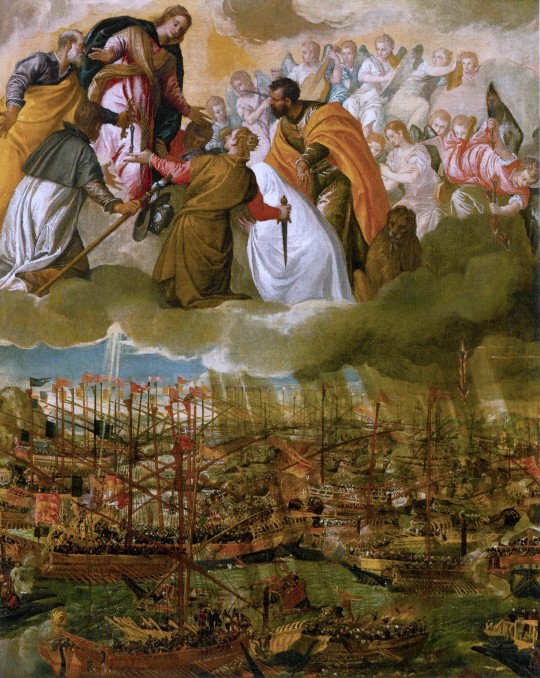#aph: Agrinio
Text
Note: The characters presented there are inspired by @allbeendonebefore's work and they have no intention to mock you, rather to entertain you.
Hello again. In my previous post, I talked about the regional unit of Aetolia-Acarnania. Here, I'm gonna present some of its important cities. Starting with the capital itself…

Artistic choices: As with Aetolia and Acarnania in the previous post, I based her design from one of my aunts. Specifically, I made her tall with brown hair. I originally intended her to have scars all over her body, from the three Sieges (that we are going to talk about later) that took place in her city, but I ended up finding this idea over-the-top and she has fair skin. She is famous as a fish farming site, so I gave her clothes that make it easy for her to access waterz like boots, shorts and a plain t-shirt.
Messolonghi (as I prefer to call her) is the capital of Aetolia-Acarnania, despite not being its biggest city (Agrinio holds this position). Think of it like Edmonton and Calgary's case in Alberta, Canada.
It's one of these greek towns that has associated itself with the Greek War of Independence, a War that lasted from 1821 to 1829, and ended with the Greeks receiving their freedom from the Ottoman Empire.
To name, during that war, three dramatic sieges took place there. The first two (in 1822 and 1823) were unsuccessful, but the third was devastated for the Messolonghians.
Let's start from the beginning. Messolonghi is a city protected by a chain of small islands and its lagoon from the sea, and by a wall and the marshy terrain from the landward side. Additionally, it emerged as a fishing and trading settlement. All these made her a place in a vital position and that's why the Ottomans attacked her.
The reason the first two sieges were unsuccessful was due to the fact that the Ottomans focused solely on cutting connections and food from the land and thanks to the town's history as as a fishing and trading settlement, the residents could supply themselves via the sea route.
On the third time, however, the Ottomans came with a much stronger navy, cutting connections from both the land and the sea. The siege lasted till the spring of 1826. The Greeks had grown devastated and weak after a long and suffering winter without supplies, even going as far as to eat dogs, cats and mice from the streets. The residents looked skeletal and you could see corpses on the ground.
It was then that the Messolonghians decided to burst out of the gates and attempt to lead the women and children to safety. Meanwhile, those who were dying and/or too sick were piled into houses packed full of gunpowder to blow themselves up when the Ottomans arrived to kill them.
On the night of 10 April, the Greeks realised their plan, having to face an army of Ottomans who were informed about their escape. 10,000 emerged. Only 1,000 Greeks made it alive.
It's one of the most popular and important event of the Greek War of Independence, as it moved thousands of Philhellenes across the globe, who came to support the Greeks and it inspired works of art, like "The Free Besieged", a poem written by our national poet, Dionysios Solomos.
Here's an unofficial English translation I found on the Internet:
A silence as prevalent as death reigns over the plains
a bird speaks, takes a seed, and the mother envies it.
The famine blackened the eyes. The mother is swearing onto the eyes.
The good soldier from Souli stands aside and cries:
"Lone dark rifle, why do I hold you in the arm,
for you are a burden to me and even the Muslim knows ?"
April and Eros are dancing and laughing together,
and as many blossoms and cores come out, so many weapons enclose you.
A small white hill of sheep yells in movement,
and gets thrown deep within the sea again,
and merges its vast whiteness with the beauties of the sky.
And into the waters of the lake, which it reached in fast,
a blue butterfly played with its shadow,
that felt its sleep within the wild Fleur-de-lys.
The petite worm is also coming on its age.
The nature is magic and a dream in beauty and grace,
the black stone and the dried up grass are vast golden.
It spills itself with a thousand faucets, it speaks on a thousand languages:
"Whoever dies today will perish a thousand times."
The theme of the poem is about temptation and it's easily obvious on the last lines, where beautiful euphemisms are used to describe nature. One could ask "Who would want to die in such a beautiful day?". But as history (or to be more precise, this episode) showed, the Greeks preferred death over becoming slaves of the Ottomans.


In this drawing, you can see a mother about to commit suicide after having killed her kid (which is seen lying in her left arm), in an attempt not to end in the arms of the Ottomans.

The Garden of Heroes, a place dedicated to important military and political figures of the city, particularly from the Greek War of Independence.
Oh, I forgot to say that Lord Byron, a famous English poet and Philhellene died there.
Honestly, I feel like I talked too much about the Greek War of Independence…
On an unrelated note, she's in a rivalry with Agrinio, the biggest city and Economic Centre of Aetolia-Acarnania, but we will discuss it later (honestly, if you're following me for a while or if you've read my #athens and thessaloniki adventures posts, you will have noticed that we Greeks don't exactly get along)…

Artistic choices: I based her body type and hair from my mom, as she grew up in a small village near Agrinio. My mom doesn't smoke, but I made her a smoker, since, as I stated in the fun fact above, Agrinio is known across Greece for its tobacco production. My mom has participated in this when she was a little girl and she has a lot to tell me about it… Plus, she isn't redhead, she's actually brunette, she just likes to dye her hair red (just like my mom).
Enjoy a video depicting the production of tobacco. My mom showed it to me and said its pretty accurate to what she did when she was little.
https://youtu.be/E-F_iOQ88Ds
Agrinio is the biggest city of the regional unit of Aetolia-Acarnania and its Economic Centre. It's not the capital however. It's a similar case like the one with Edmonton and Calgary in Alberta, Canada.
It has acquired one of the worst reputations among greek cities, as a city that you "should avoid at all costs" and its residents as people you "should avoid at all costs". Here, I'm going to dissolve this ugly reputation or at the very least, try to justify it.
Agriniots in general are seen as "savages" that speak terribly greek. The reason for this is because, unbestknown for the majority of non-Agriniots, the people who claim to be from Agrinio aren't from Agrinio. They're from nearby villages, they just say Agrinio to help the listener locate the place. And because villagers have this reputation as being uncivilised and because every village speaks with a different accent, Agriniots earned the aforementioned reputation.
They're also in a rivalry with Messolonghi. The best way I can describe it is like this:
Agrinio: I'm the biggest city and Economic Centre of this regional unit! Why is SHE the capital?!
Messolonghi: I deserve this title because I'm an historic city!
Etc, etc

Artistic choices: He's a lobster, because his name "Astakos" in Greece means lobster and I thought it was funny. However, I don't know how he got that name. I searched information online and I didn't find anything about Astakos being famous for his lobster farming.
Nothing to say, except that it's a nice village to stroll and have dinner if you ever find yourself in Greece. Plus, I liked this building when I visited it.


Artistic choices: When most foreigners think about us Greeks, they think of slightly tanned people with brown or black hair. This is to a great extent true. For this reason, I wanted to create a character that looked less "Greek" and more "foreigner" just for the fun of it. She would be woman, have blonde hair (for the record, there're Greeks who have blonde hair, but there're huge brown hues on it. I wanted her hair to be pure blonde) and blue eyes. And that's how Nafpaktos came to be!
During the time she was under the Venetian Republic, she was named Lepanto. It's also the place where the Battle of Lepanto happened. You probably have heard it at least one in your life, as it's one of the most famous naval battles, and if you're Spaniard, it rings a bell in your ear.
It's considered of vital importance to the Europeans, since it marked the turning-point of Ottoman military expansion into the Mediterranean. Miguel de Cervantes, whom you might know as the author of Don Quixote, participated, where he severely injured his arm. In fact, there's a statue of him lifting his right arm, the arm which he used to write several famous literature works.


She's also the second biggest city of Aetolia-Acarnania after Agrinio.
That's all I have to offer. Have a good day (or night depending on what time exactly you're reading this post) 😘. The next post is gonna be the last about the Aetolia-Acarnanian Gang!
Sources:
A small part where I list all the sources of my information:
For Aetolia-Acarnania:
https://el.m.wikipedia.org/wiki/%CE%9D%CE%BF%CE%BC%CF%8C%CF%82_%CE%91%CE%B9%CF%84%CF%89%CE%BB%CE%BF%CE%B1%CE%BA%CE%B1%CF%81%CE%BD%CE%B1%CE%BD%CE%AF%CE%B1%CF%82
https://el.m.wikipedia.org/wiki/%CE%99%CF%83%CF%84%CE%BF%CF%81%CE%AF%CE%B1_%CF%84%CE%B7%CF%82_%CE%91%CE%B9%CF%84%CF%89%CE%BB%CE%AF%CE%B1%CF%82
https://el.m.wikipedia.org/wiki/%CE%99%CF%83%CF%84%CE%BF%CF%81%CE%AF%CE%B1_%CF%84%CE%B7%CF%82_%CE%91%CE%BA%CE%B1%CF%81%CE%BD%CE%B1%CE%BD%CE%AF%CE%B1%CF%82
https://en.m.wikipedia.org/wiki/Aetolia-Acarnania
https://en.m.wikipedia.org/wiki/Aetolia
https://en.m.wikipedia.org/wiki/Aetolian_League
https://en.m.wikipedia.org/wiki/Acarnania
For Messolonghi:
https://en.m.wikipedia.org/wiki/Missolonghi
https://en.m.wikipedia.org/wiki/Third_siege_of_Missolonghi
https://en.m.wikipedia.org/wiki/First_siege_of_Missolonghi
https://en.m.wikipedia.org/wiki/Second_siege_of_Missolonghi
https://el.m.wikipedia.org/wiki/%CE%9C%CE%B5%CF%83%CE%BF%CE%BB%CF%8C%CE%B3%CE%B3%CE%B9
https://el.m.wikipedia.org/wiki/%CE%88%CE%BE%CE%BF%CE%B4%CE%BF%CF%82_%CF%84%CE%BF%CF%85_%CE%9C%CE%B5%CF%83%CE%BF%CE%BB%CE%BF%CE%B3%CE%B3%CE%AF%CE%BF%CF%85
For Agrinio:
https://el.m.wikipedia.org/wiki/%CE%91%CE%B3%CF%81%CE%AF%CE%BD%CE%B9%CE%BF
https://en.m.wikipedia.org/wiki/Agrinio
For Astakos:
https://en.m.wikipedia.org/wiki/Astakos
https://el.m.wikipedia.org/wiki/%CE%91%CF%83%CF%84%CE%B1%CE%BA%CF%8C%CF%82_%CE%91%CE%B9%CF%84%CF%89%CE%BB%CE%BF%CE%B1%CE%BA%CE%B1%CF%81%CE%BD%CE%B1%CE%BD%CE%AF%CE%B1%CF%82
For Nafpaktos:
https://el.m.wikipedia.org/wiki/%CE%9D%CE%B1%CF%8D%CF%80%CE%B1%CE%BA%CF%84%CE%BF%CF%82
https://en.m.wikipedia.org/wiki/Nafpaktos
https://en.m.wikipedia.org/wiki/Battle_of_Lepanto
https://iaitoloakarnania.gr/2020/04/to-agalma-toy-thervantes-sti-naypakto-o-don-kichotis-kai-i-schesi-toy-me-tin-ellada/
#aph oc#aph: Messolonghi#aph: Missolonghi#hws Messolonghi#hws Missolonghi#aph ocs#aph: Agrinio#hws Agrinio#aph: Astakos#hws Astakos#aph: Nafpaktos#hws Nafpaktos#aata#athens and thessaloniki adventures
4 notes
·
View notes